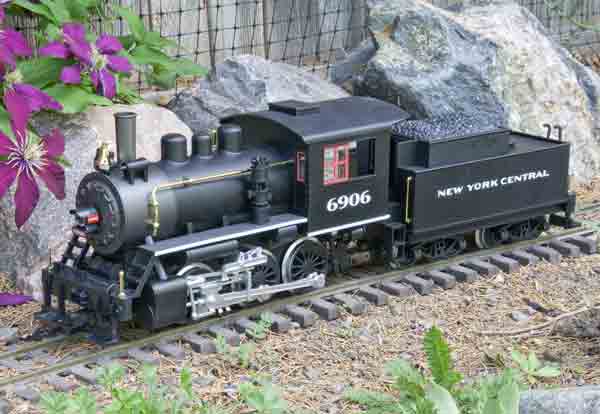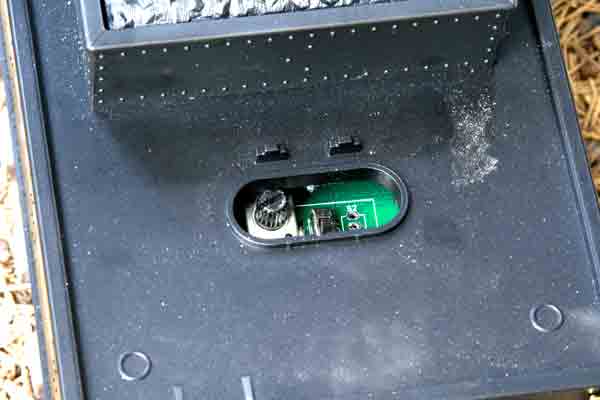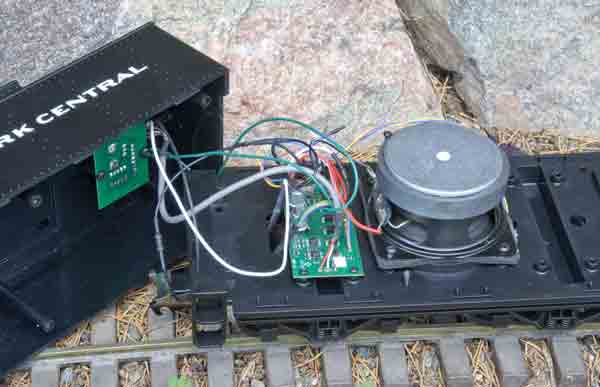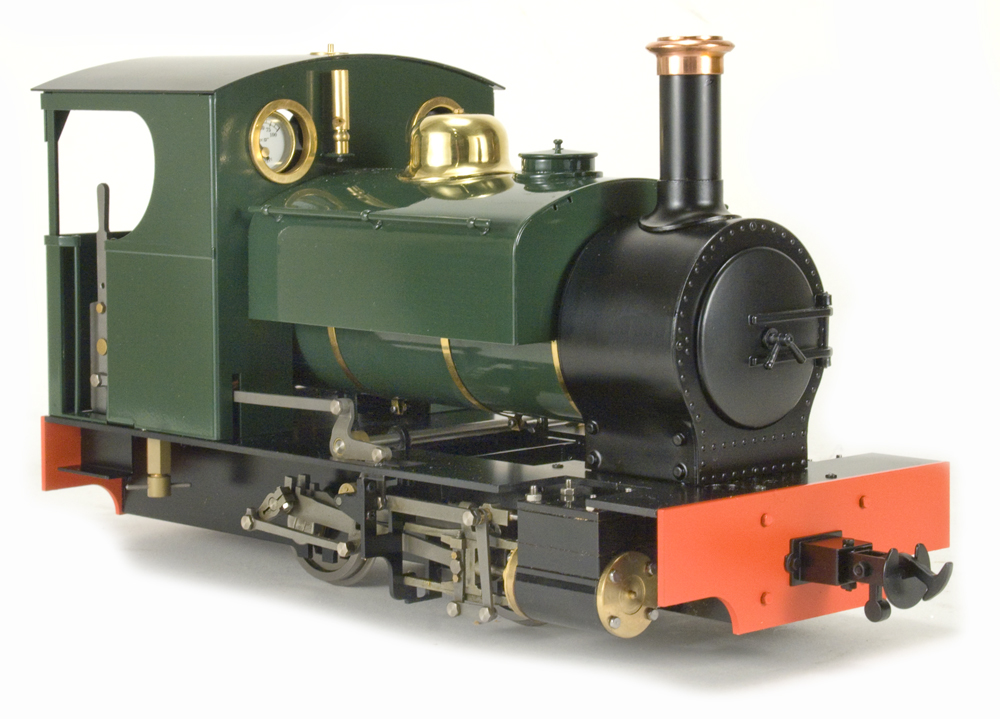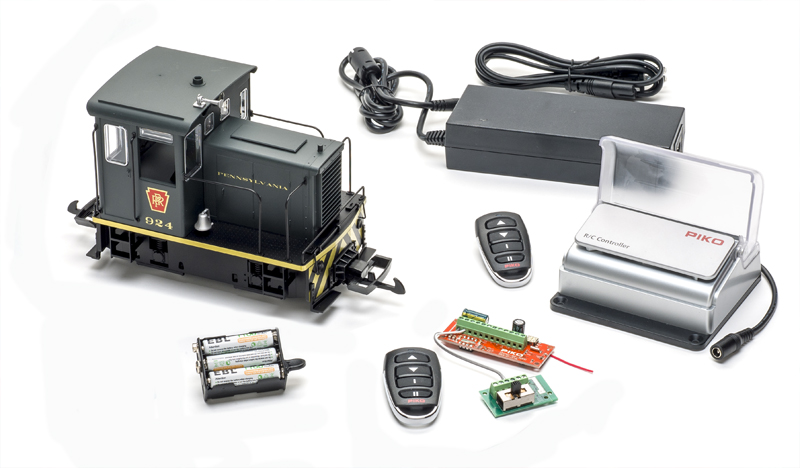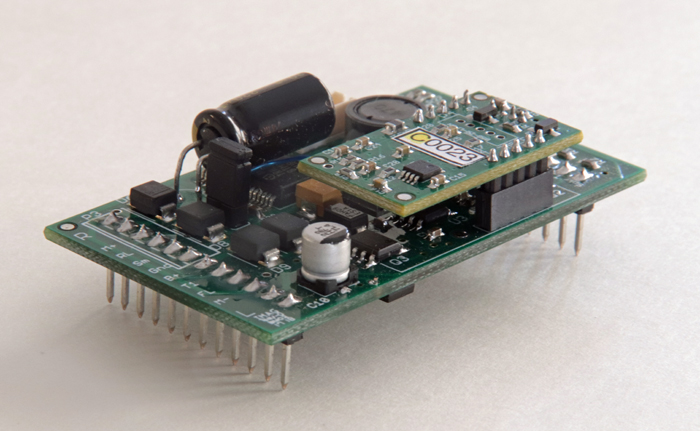Piko America, LLC
4610 Alvarado Canyon Road, Suite 5
San Diego CA 92120
Price: $469.99 (decoder available separately: $144.99)
Website: www.piko-america.com
Plastic, gauge 1, freelance, steam-outline 0-6-0; integrated DCC control and sound; also compatible with traditional analog DC track power; directional lights; whistle blows correct forward/reverse signals when starting; smoke unit; hook-and-loop couplers; minimum radius, 24″. Dimensions: length, 22½”; width, 41⁄8″; height, 6 5/8″
Pros: Good quality digital sound; multiple whistles to choose from; sturdy construction; smooth operation; crisp graphics
Cons: No track pick-up from tender wheels; must use DCC to program sounds for analog operation; chuff not synchronized to driver rotation with an axle cam; details sparse; shiny gold handrails; instruction booklet vague on specifics of adjusting CVs, referring user to website; no scale specified
Piko now offers both this 0-6-0 and their 2-6-0 with built-in digital sound and motor-control electronics. This is a DCC-compatible system that also allows for traditional analog track-power control. The sound and control electronics for this engine are located in the tender. The instruction book nicely illustrates how it is installed and wired. The system features a three-amp motor output, separate five-volt outputs for smoke and front and rear lights, and a three-watt amplifier for the sound (with an all-important volume knob located under the water hatch on the tender). It also comes with magnetic triggers for activating the bell and whistle, using track magnets.
As the decoder is supplied from the factory, the DCC electronics are set up for both analog and DCC control so, whether you’re running on a “traditional” DC-powered railroad or under DCC control, you can enjoy the sounds this locomotive offers. I’ll begin with DC operation.
When running this locomotive on analog track power, you must have a filtered DC signal going to the motor. The decoder will not operate on pulse-width-modulation (PWM) track power. Also, your track power cannot exceed 27V. If it does, the decoder will shut itself down until the voltage drops to a safe level. The decoder will automatically determine whether it’s on a DC or DCC-powered track, and will adjust itself accordingly.
When you set the locomotive on the track and begin to turn up the throttle, nothing happens. This is normal.
The locomotive must receive around 6V before it will do anything. That’s because the decoder needs this minimum voltage to operate; it then controls the voltage that goes to the motor. Once the decoder has sufficient voltage, it sets that as the “floor,” in terms of the voltage going to the motor, then increases it from there. The result is that you lose 6V or so from the power available to the motor. So, with a 14V power supply, you’ve only got 8V available for the motor; with a 24V power supply, you’ll have 18V. If you try to run a decoder-equipped Piko 0-6-0 with a non-decoder-equipped Piko 0-6-0, the non-decoder-equipped engine will start sooner and run faster than the decoder-equipped one, so double-heading the two won’t work. Top speed with a 22V power supply was a manageable 35 scale miles per hour.
When the locomotive begins to move, the whistle will sound the correct two toots for forward or three toots for reverse, although, technically, to be absolutely correct, the whistle should sound before the engine begins to move. The headlight or back-up light on the tender will also illuminate, relative to the direction of travel. From this point, the bell begins to ring as the locomotive starts out, and the engine begins to chuff. Track magnets will either trigger a grade-crossing whistle signal or ring the bell, depending on orientation. (Alas, the illustration for orienting the magnets, referred to in the instruction manual, somehow got left out of the book.)
The chuff of the locomotive is based on motor voltage; there is no synchronized chuff trigger. You’re left to the mercy of whatever default value was programmed into the decoder to determine how many chuffs per driver revolution you get. I found the default rate a bit slow for my taste. The chuff rate, however, can be changed by adjusting CV 116, although you will never achieve true synchronization.
Under analog DC control, whatever parameters are programmed onto the board are what you get. The board allows you to program different whistles, adjust volume levels, chuff rates, etc., but you must use the DCC interface to do so. If you have a friend who runs DCC in a smaller scale, you can grab two alligator clips, connect them from his track to the pick-up skates on the 0-6-0, and reprogram the board to your heart’s content. There are specific settings relative to the locomotive’s behavior under analog control that you can adjust, in addition to other features.
With DCC operation, you can customize a lot about this locomotive’s performance. There are three whistles to choose from, all of which sound nice. You can adjust the individual volume levels of the various sounds in relation to one another and adjust the chuff rate so that it gets close to being properly “quartered,” etc. The instructions refer you to the company’s website for specifics but, as of this writing, the full manual for the decoder had yet to be completed and uploaded. Piko tells me that it should be uploaded by the time this review hits the newsstands. Given that, I could only customize certain parameters for which I had documentation. (Note: This documentation didn’t come with the locomotive. Piko sells the decoder that’s in this locomotive as a separate item and I just happened to have one on hand for my DCC series. This contained a little more documentation but still not the full manual.) Having said that, the features I could customize (choosing the whistle, adjusting the chuff rate, and the motor control parameters that are universal to DCC) all went well, resulting in smooth slow-speed operation and even starts and stops.
Compared to other stand-alone DCC decoders, this one is fairly basic. But then, it’s designed specifically to go into a fairly basic locomotive, so it fits that role well. The thing to remember is that what we consider “basic” today is far removed from what we called basic just 10 years ago. Whether you’re looking at the locomotive/decoder package together or just thinking the decoder itself might work well in another engine you already own, you’ll find the quality and features of this decoder to be adequate for most applications.





